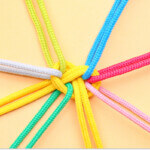Are some of us just born more creative than others? Is creativity a skill that anyone can cultivate? What is the “creative brain”? These types of questions have puzzled psychologists for decades. While there is evidence for both nature and nurture arguments, creativity is clearly affected by internal and external factors.
Creative instincts, however, seem to diminish over time. Psychologists George Land and Beth Jarman conducted a landmark study in 1968 which tested creativity in 16,000 children. The test was designed for NASA to identify innovative engineers and scientists at a young age. What was particularly interesting was how the scores changed drastically with age. The five-year-olds were the most creative group, with 90% scoring highly. Adults were the least creative group, with only 2% scoring highly on creativity.
A complicated trait to measure, creativity is heavily influenced by cognitive development and nurtured by a person’s environment.
Creativity As Defined By Psychologists
Psychologists define creativity as “the ability to produce or develop original work, theories, techniques, or thoughts.” It’s also often defined as having an idea that is inherently new and valuable.
Creative people often show that they are more prone to have traits like a strong imagination and expressiveness.
One scientific study comparing twins, published in Behavioural Genetics, found creativity is in larger part inherited. They measured creative heritability to be about 70% due to genetics. That still leaves plenty of room for the environment to influence levels of creativity.
Regardless of how much our genes influence creativity, we can still nurture that spark.

Training the Brain to Be More Creative
For many businesses, encouraging creativity and innovation is critical to long-term success. The cubicle has given way to the open-office concept, indoor rock-climbing walls, and bean bags.
From a scientific perspective, there are ways to boost your creativity. Here are a few different ways to improve your creative skills, with the science of psychology to support them.
Get More Sleep
Taking care of mental and physical health is the first thing to do. Getting enough sleep is probably the most basic and essential means of improving your creativity.
It seems to partially depend on the type of sleep. For example, REM sleep (the “dream phase”) promotes creative problem-solving. Researchers believe this is because the brain replays memories to learn from and moves those thoughts into long-term memory.
Some studies have found that creative individuals tend to sleep more. Even if they aren’t always getting the best quality sleep, getting in the hours still positively impacts their creativity.
In a few cases, dreams themselves have led to scientific breakthroughs. James Watson, for example, had a dream about two serpents that were intertwined. That dream eventually led him to discover the double helix shape of DNA.
Five other interesting creative breakthroughs people had in their sleep:
- Paul McCartney woke up humming the tune for Yesterday.
- James Cameron got the idea for The Terminator.
- Dimitri Mendeleev worked for three days, then fell asleep for twenty minutes – and dreamed up the periodic table of elements.
- Jack Nicklaus dreamt up a new way to swing his golf club.
- Elias Howe dreamt he was on his way to be beheaded if he didn’t invent a sewing needle. He woke up and had it done in a few hours.
Don’t Use a Reward System
Often, people think that rewards, or positive reinforcement, are a good way to improve performance. And while it helps form new, ongoing habits—it does not always help boost creativity.
According to the psychology of creativity, this is because of a phenomenon known as the Overjustification Effect. The effect occurs when the reward for the behavior backfires, and the additional incentive instead makes you no longer want to do that task.
To illustrate this, imagine your team is working on a new logo for a brand. You probably got into graphic design because the creative act of designing drove you. However, your department suddenly offers a reward, like a free lunch for the best design. Now, the reward isn’t the act of creation itself; it’s the free lunch. If you aren’t interested in the lunch, you’re less incentivized to perform.
The lesson here is that if you’re stuck on a creative task and hitting a wall, avoid relying too heavily on a reward system to motivate yourself or your team. Instead, look to other forms of recognition for motivators.
Find Your Creative Environment
Positive psychologist, Mihaly Csikszentmihalyi, is known for his theories on the study of the mental state of flow. A cornerstone of his framework is the notion that our surroundings play a critical role in the creative process.
“Creativity does not happen inside people’s heads, but in the interaction between a person’s thoughts and sociocultural thoughts and a sociocultural context.” — Creativity, Mihaly Csikszentmihalyi
It helps to have a stimulating and well-thought-out environment that can facilitate creativity. Working in a space with elements that inspire you can help if you’re in a creative rut or looking for an extraordinary brainstorming session.
For brainstorming, developing ideas, and other creative tasks, you might want a fun, engaging, and energizing work location. However, when you actually need to execute your creative project, avoid working in an overly stimulating space. You don’t want to be in an environment that distracts you from the task at hand.

Creativity—especially on the execution side—often needs to happen in less-than-exciting places. So, when it comes to completing your creative tasks, find or build a space where you can focus.
Agatha Christie was known to write her books while staying in hotels. Maya Angelou was famous for this same creative habit. They did this because the hotel had fewer distractions than at home, so they could focus on the writing and nothing else.
Depending on what stage of the creative process you’re in, make sure your environment matches it.
Work With Constraints
What’s easier: to start with a blank page or an almost blank page with a single prompt on it?
Many artists and writers already know that a blank page is intimidating. The open-ended nature makes it challenging to get started because of the infinite possibilities. That’s why so many begin with prompts to give a jumping-off point and inspiration.
Shockingly, creativity absolutely thrives when you put it in a box.
The success of constrained creating is, in part, attributed to the theory of non-linear thinking. Non-linear thinking is when a person connects typically unrelated ideas. Constraints can help connect those ideas because you’re taking a different path than you normally would. The constraint might give you a more linear starting point, but it will also make it easier to expand on the problem in a new and non-linear way.
Many of the greatest creations of our time were born out of a constraint. Take the iconic video game music produced by Koji Kondo for Nintendo’s game, Super Mario. When creating the game music, he could only use six notes due to the limitations of the technology at the time. And yet, he composed a catchy tune that would become recognizable to gamers around the world.
One of Dr. Seuss’ most successful books came out of constraints. Over drinks, his friend challenged him to write a story only using fifty different words—no more, no less. That would eventually turn into the most successful story he ever published—Green Eggs and Ham.
For the record, the entire book is written with only the words: a, am, and, anywhere, are, be, boat, box, car, could, dark, do, eat, eggs, fox, goat, good, green, ham, here, house, I, if, in, let, like, may, me, mouse, not, on, or, rain, Sam, say, see, so, thank, that, the, them, there, they, train, tree, try, will, with, would, you.
Design Creative Collaboration Spaces
As the saying goes, two heads are better than one. Working with others is a fantastic way to be more creative. But it’s not just bouncing ideas off other people that help, it’s the space around you, too.
In 2015, one study looked at how the physical space influences our creativity, and researchers found that physical environments, where users can socialize and share ideas, boosted the outcomes of creativity.
Some businesses are already applying this to their offices. In 2017, Apple announced its “Apple Park,” which was designed with collaboration and creativity in mind. They did this to help encourage more innovation and spark ideas for their 12,000 employees.
Think About it Another Way
“We cannot solve our problems with the same thinking we used when we created them.” – Albert Einstein
If you’re feeling stuck creatively, try to approach the problem from another angle. Most creative people tend to approach things differently. Here, we’re going back to that non-linear thinking I mentioned earlier.
Another common method to use is the Six Hats Technique coined by Dr. Edward de Bono. This strategy attempts to challenge your brain to approach a problem from 6 different points of view. Essentially, you put on a different hat, and each one offers a unique perspective.
The Six Hats breakdown technique is:
- Facts
- New Ideas/Creativity
- Positive/Benefits
- Negative/Cautions
- Feelings
- Big Picture/The Process
By framing your thoughts along these different tracks, you can approach your ideas from a new angle you never considered before.

Embrace Boredom
Another interesting and seemingly counterintuitive tip is to do repetitive or monotonous tasks to increase your creativity.
In one study, British researchers gave participants two conditions to test boredom and creativity. First, the participants were asked to do a boring task (like copying numbers) or no task before then attempting a creative task. The group that engaged in a boring task performed better on measurements of creativity than the control group who didn’t do the dull task.
One theory for why boredom fosters creativity is that it allows us to embrace daydreaming. Who hasn’t zoned out at times when doing something repetitive?
The trick here is to consciously use that boring and repetitive task to develop your creativity.
The Creative Brain: Your Best Creative Work
While creativity has a natural component, it’s clear that your best creative work is possible to improve by thinking outside the box (or inside the box, too). Next time you’re in facing creative block, consider the science backing up the psychology of creativity. Try adding constraints, doing boring tasks, or working in a collaborative space to spark new concepts.
Creativity is a skill that anyone can develop and refine. Some of us just need a little bit of help and certainly some practice.






